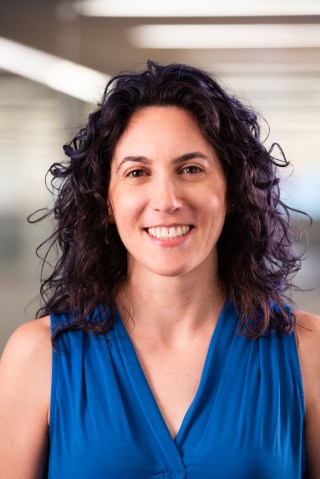Americans who are lesbian, gay, bisexual or transgender (LGBT) tend to be less religious than those who are not LGBT. In addition, adults who are lesbian, gay or bisexual have more negative views than other U.S. adults do about religion, though many say religion plays some positive roles in society.
But when it comes to some questions about spirituality – such as whether human beings have a soul or spirit – the gaps between lesbian, gay or bisexual adults and other people tend to be smaller.
This Pew Research Center analysis explores how adults who are lesbian, gay, bisexual or transgender approach religion and spirituality. Our findings hold even after controlling for age and other demographic traits.
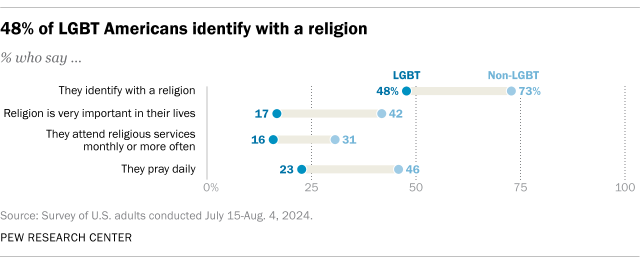
Religion among lesbian, gay, bisexual or transgender Americans
Roughly half of U.S. adults who are LGBT (48%) say they identify with a religion, describing themselves as Christian, Jewish, Muslim or an adherent of another religion. By comparison, 73% of non-LGBT Americans identify with a religion, according to a Center survey conducted in summer 2024.
Meanwhile, 52% of LGBT adults are religiously unaffiliated, which is about double the share of non-LGBT Americans who say the same (26%). The religiously unaffiliated category includes people who identify as atheist, agnostic or “nothing in particular” when asked about their religion. LGBT Americans are more likely than non-LGBT adults to identify with each of these subgroups.
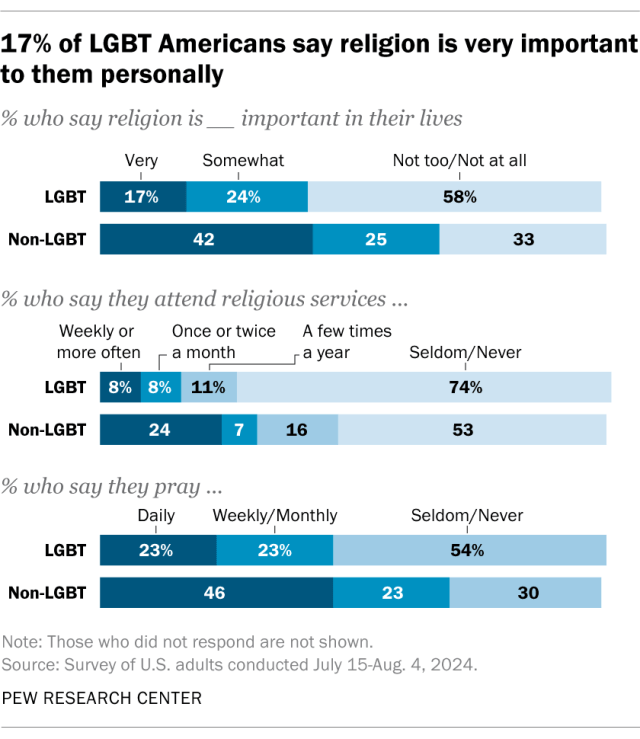
LGBT Americans also are far less likely than non-LGBT adults to say religion is very important to them personally (17% vs. 42%). And they are about half as likely as non-LGBT adults to say they attend religious services at least monthly (16% vs. 31%) or pray daily (23% vs. 46%).
Overall, 8% of Americans are LGBT, according to our survey.
Spirituality among adults who are lesbian, gay or bisexual
A different Center survey – the 2023-24 Religious Landscape Study (RLS) – explored spiritual beliefs, practices and experiences among those who identify as lesbian, gay or bisexual. (The RLS did not include a question about transgender identity.)
Despite being less religious, large shares of lesbian, gay and bisexual Americans hold spiritual beliefs. For example, 80% say they believe “people have a soul or spirit in addition to their physical body.” And 69% believe “there is something spiritual beyond the natural world, even if we cannot see it.”
Lesbian, gay and bisexual adults are about as likely as other Americans to say that they do the following at least once a week:
- Feel awe at the beauty of nature (62% of lesbian, gay and bisexual adults vs. 62% of other Americans)
- Visit a nature spot for spiritual reasons (16% vs. 14%)
- Meditate for spiritual reasons (21% vs. 23%)
On some other questions, the gaps are wider. For example, 64% of lesbian, gay or bisexual adults believe in God or a universal spirit, compared with 85% of other Americans. And 46% say they believe in an afterlife (heaven, hell or both) while 72% of other Americans do.

Views about religion and religious institutions among lesbian, gay and bisexual people
The RLS also asked Americans about religious institutions and religion’s role in society. Lesbian, gay and bisexual adults have far more negative views than other Americans on these topics.
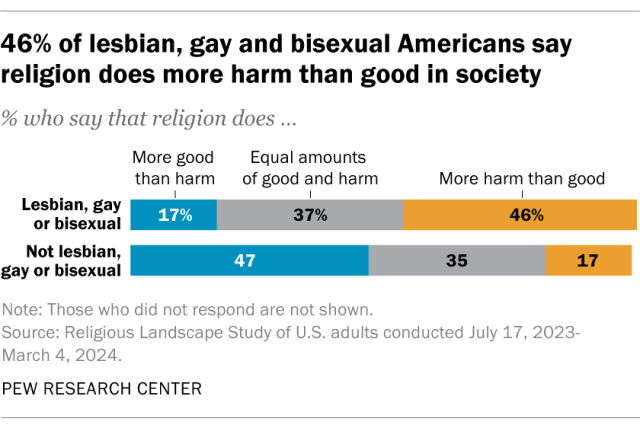
For example, 46% of lesbian, gay and bisexual Americans say that religion does more harm than good in American society. Another 17% say religion does more good than harm, and 37% say it does equal amounts of good and harm.
By contrast, 17% of Americans who aren’t lesbian, gay or bisexual say religion does more harm than good.
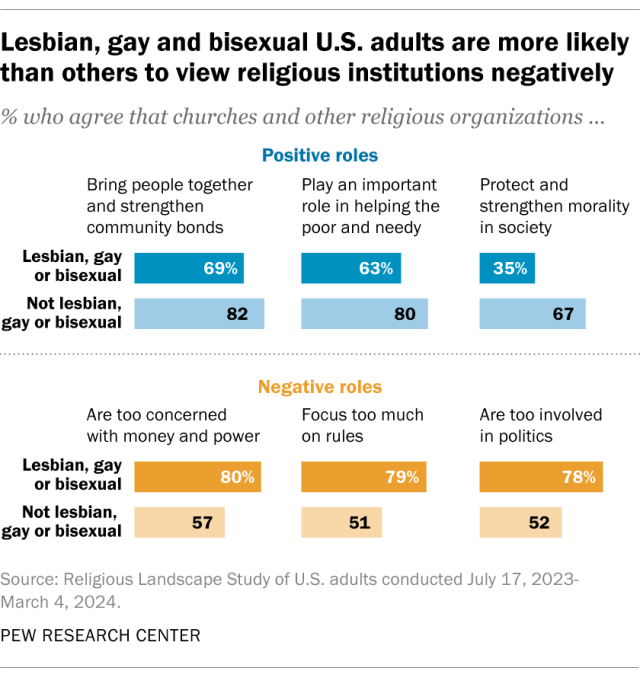
Lesbian, gay and bisexual adults also are far more likely than others to say that religious organizations are too concerned with money and power (80% vs. 57%). And they are far less likely to say that churches and other religious organizations strengthen morality in society (35% vs. 67%).
However, lesbian, gay and bisexual adults also see some positive aspects of religion. Majorities say that churches and religious organizations bring people together and strengthen community bonds (69%) and that they play an important role in helping the poor and needy (63%).
Impact of age and other factors in differences between LGBT adults and other Americans
Some of the differences in religiousness, spirituality and attitudes about religion may be tied to the fact that Americans who identify as lesbian, gay, bisexual or transgender are younger, on average, than other U.S. adults. Many Center studies over the years have shown that young people tend to be less religious than older people and are less likely to say religion causes more good than harm.
We ran regression analyses to examine the independent effects of factors such as age, gender, political affiliation, educational attainment, income level, race and ethnicity, and geographic region. The patterns we describe in this analysis hold even after controlling for these traits.
